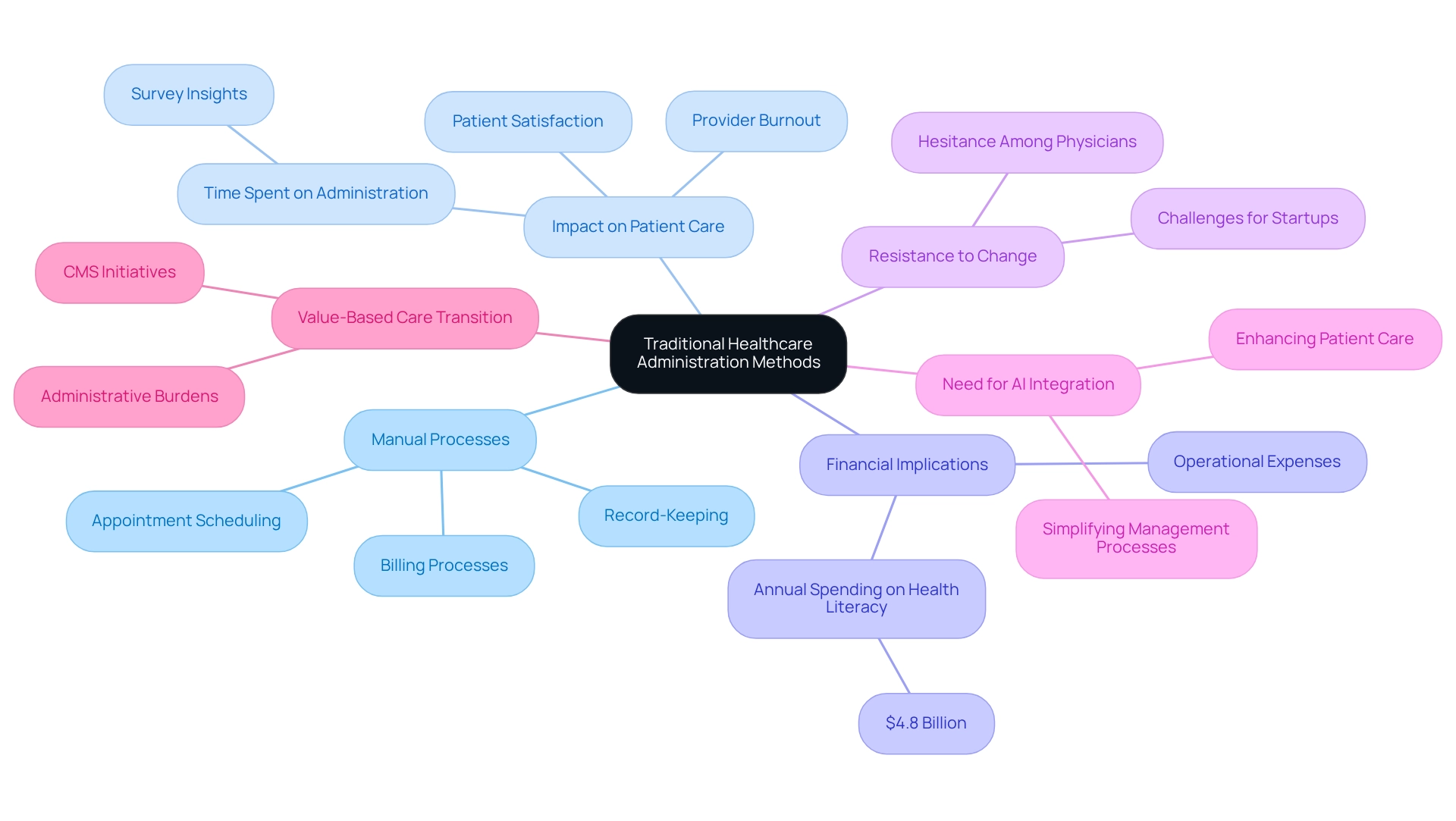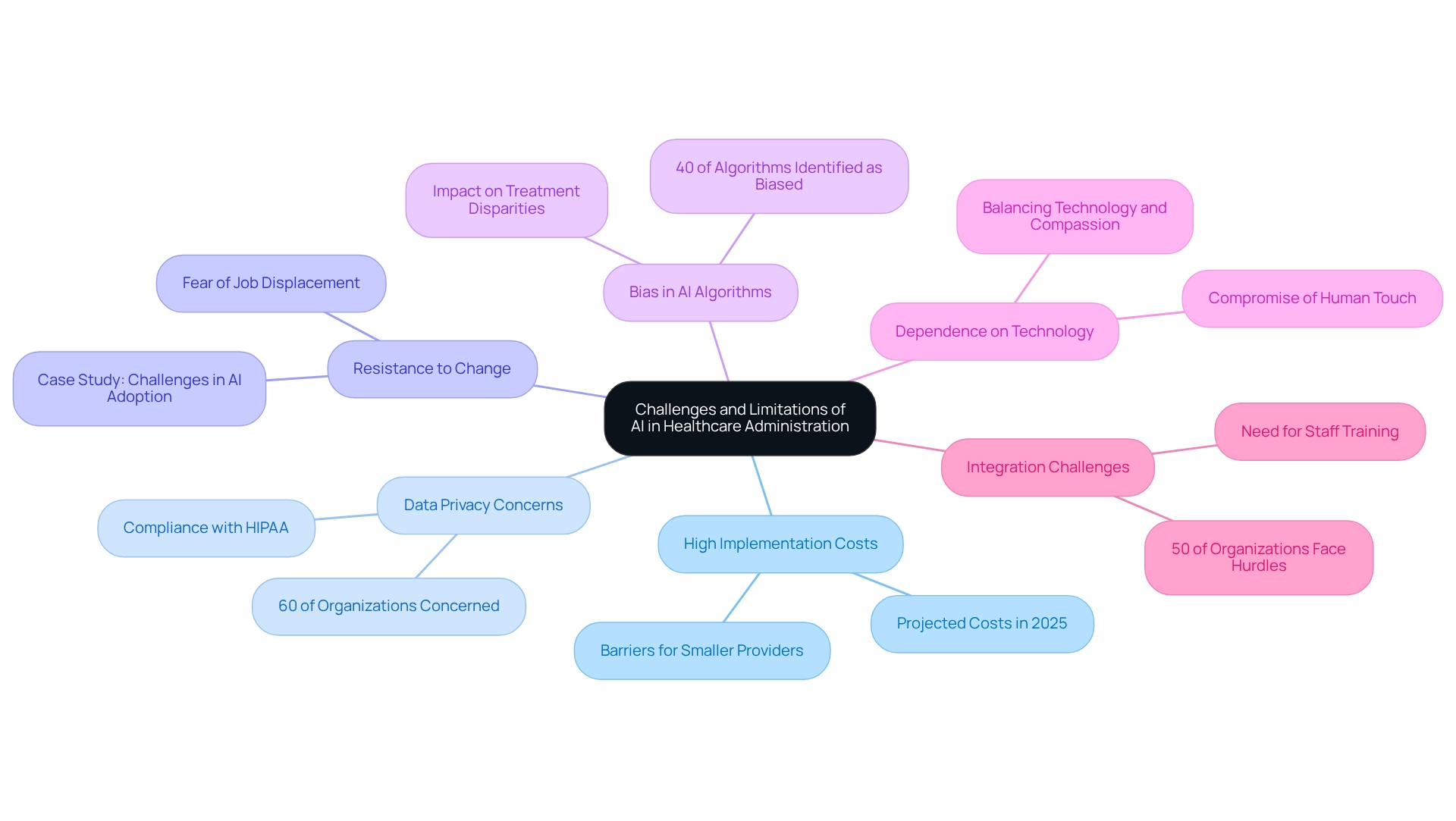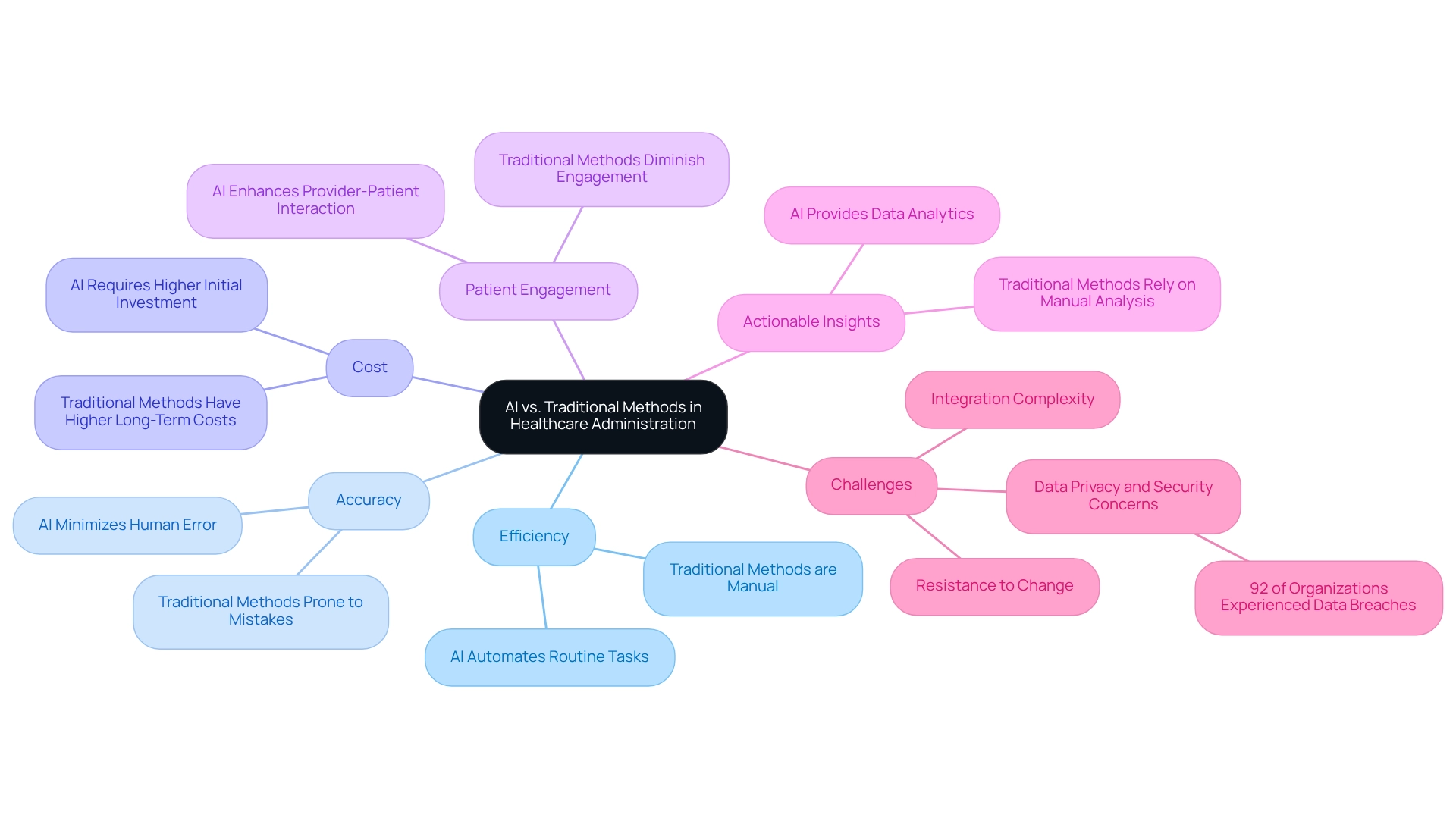Overview
This article delves into the emotional challenges faced by healthcare providers when integrating AI into administration. The burden of administrative tasks can weigh heavily, impacting both efficiency and patient care. It’s important to recognize how these pressures affect not just the workflow but the overall well-being of both staff and patients.
AI offers a promising solution, potentially streamlining routine tasks and alleviating some of these burdens. By automating processes, reducing operational costs, and providing valuable data-driven insights, AI can significantly enhance efficiency. However, the journey is not without its hurdles. High implementation costs, concerns about data privacy, and resistance from healthcare professionals are significant challenges that must be navigated.
Despite these obstacles, the benefits of AI in healthcare administration are compelling. Imagine a system where healthcare providers can focus more on patient care rather than paperwork. This shift not only improves operational efficiency but also fosters a more nurturing environment for patient interactions.
To truly embrace this transformation, it’s essential to engage in open conversations about these challenges and explore collaborative solutions. How can we work together to address these concerns? By fostering a supportive dialogue, we can pave the way for a future where AI enhances the healthcare experience for everyone involved.
Let’s take the next step together. By acknowledging the emotional landscape of healthcare administration and exploring the potential of AI, we can create a more efficient and compassionate healthcare system.
Introduction
In the rapidly evolving landscape of healthcare, many providers are feeling the weight of administrative burdens. The integration of Artificial Intelligence (AI) offers a promising solution, revolutionizing practices and fostering a future where efficiency and patient care truly go hand in hand. By harnessing advanced algorithms and machine learning, AI is streamlining essential tasks like scheduling, billing, and data management. This shift allows healthcare providers to refocus on what matters most: compassionate patient care.
As operational costs rise and administrative challenges mount, the move towards AI-driven solutions is not just an upgrade; it represents a fundamental transformation in how care is delivered. Imagine a world where healthcare professionals can dedicate more time to their patients, enhancing the quality of care. With projections indicating substantial growth in the AI healthcare market, the benefits of operational efficiency, cost reduction, and improved patient engagement are profound.
However, as organizations embark on this journey, they must navigate the challenges and limitations that accompany such a technological leap. It’s crucial to ensure that the compassionate ethos of healthcare remains at the forefront. By embracing AI thoughtfully, we can create a healthcare environment that not only meets operational needs but also nurtures the human connection that is so vital in patient care. How might your organization harness this technology to support your mission? Let's explore this transformative potential together.
Understanding AI in Healthcare Administration
The use of AI in healthcare administration represents a transformative opportunity for healthcare providers, addressing the emotional and operational challenges they face. By employing advanced algorithms and machine learning techniques, AI can automate and enhance essential functions such as scheduling, billing, documentation, and data management. Imagine the relief of recognizing patterns in extensive datasets that forecast results and streamline workflows—significantly reducing the administrative burden on medical professionals. This allows doctors to optimize processes like appointment scheduling and medical record management, enabling them to focus more on delivering high-quality care to their patients.
The potential of is remarkable, projected to reach USD 258.5 billion by 2025, with a compound annual growth rate (CAGR) of 38.73% from 2023 to 2032. This rapid growth highlights AI's vital role in transforming medical administration, especially for faith-oriented providers striving to enhance operational capabilities while adhering to ethical standards. Deep learning algorithms have achieved impressive accuracy levels, comparable to human experts, ranging from 86.4% to 90.5% across various applications. Additionally, a significant 58% of medical executives are likely to implement or acquire generative AI solutions within the next year, reflecting a strong trend toward embracing AI technologies.
Integrating AI is more than just a technological upgrade; it signifies a paradigm shift in service delivery. By automating routine tasks, healthcare providers can dedicate more time to meaningful interactions with individuals, ultimately enhancing the quality of service. For instance, AI-driven robotic surgery is anticipated to evolve into a $10 billion industry by 2030, improving surgical accuracy and recovery outcomes. Such advancements resonate deeply with the compassionate care ethos central to Catholic teachings, ensuring that technology serves to enhance patient well-being. However, successful AI implementation in medical environments requires specialized training for professionals to operate these advanced systems effectively.
Experts indicate that among leaders in the medical field adopting generative AI, 59% are collaborating with third-party vendors to develop tailored solutions. This proactive approach not only harnesses AI's potential but also showcases a commitment to ethical considerations in medical settings, particularly within faith-based contexts. The key advantages of AI in healthcare administration include enhanced efficiency, reduced operational expenses, and increased job satisfaction for providers. This enables them to focus on providing compassionate care rather than being overwhelmed by administrative tasks. Overall, AI's impact on medical workflows is profound, paving the way for a more efficient and patient-centered system that aligns with the values upheld by CosmaNeura.
Exploring Traditional Healthcare Administration Methods
Traditional medical administration techniques often involve manual processes for scheduling, billing, and managing medical records, which can feel overwhelming for healthcare providers. These methods typically rely on outdated paper-based systems or basic electronic health records (EHRs), requiring significant human intervention. For instance, appointment scheduling can lead to numerous phone calls and confirmations, while billing can become convoluted, resulting in frustrating errors and delays. As a result, medical providers find themselves dedicating a substantial amount of time to record-keeping, which detracts from their ability to offer direct care to individuals.
This inefficiency can lead to rising operational expenses and increased burnout rates among medical staff, ultimately affecting patient satisfaction. Have you ever felt that administrative duties, often seen as nonclinical elements of service, consume too much of your valuable time? A recent survey highlighted that these tasks take up a significant portion of time that could otherwise be spent interacting with patients. This inefficiency not only burdens providers but also places a financial strain on the medical system, with insurers and employers spending an estimated $4.8 billion each year to support consumers with low health insurance literacy.
As the medical landscape evolves, the limitations of traditional methods become increasingly apparent, highlighting the urgent need for AI in healthcare administration to foster innovations. Yet, a considerable segment of the healthcare industry remains hesitant to embrace these changes, particularly among physicians who prioritize the quality of service and patient interactions. This resistance can pose a significant challenge for startups aiming to implement AI in that could simplify management processes and enhance patient care.
Moreover, the shift to value-based services, as promoted by the Centers for Medicare & Medicaid Services (CMS), introduces additional complexities. Organizations must navigate the operational challenges of demonstrating quality results while ensuring resources are available for individuals receiving treatment. This transition highlights the pressing need for efficient procedures that can alleviate the workload on service providers, allowing them to focus on delivering high-quality care, especially with the integration of AI in healthcare administration.
Addressing the concerns raised by medical professionals regarding AI solutions is vital for overcoming these barriers and fostering an environment conducive to innovation. Given these challenges, all parties involved in the medical system—including providers, insurers, and policymakers—must prioritize process simplification to enhance operational efficiency and improve patient outcomes. Together, we can create a more supportive and effective healthcare environment.

Advantages of AI in Healthcare Administration
The integration of AI in healthcare administration offers a compassionate response to the challenges faced by healthcare providers, reshaping the industry in meaningful ways, including increased efficiency through the automation of routine tasks such as scheduling, medical record management, billing, and documentation, which significantly alleviates the administrative burden on medical service providers. This shift allows clinicians to reclaim valuable time for patient care, ultimately enhancing the quality of service they can provide.
- Enhanced Accuracy: AI systems work diligently to minimize human errors in billing and coding, ensuring precise claims submissions. This improvement is crucial for effective revenue cycle management, guaranteeing that organizations receive appropriate compensation for the care they deliver.
- Cost Reduction: Streamlining management processes through AI not only boosts efficiency but also lowers operational costs. By reducing reliance on extensive administrative personnel, medical organizations can allocate their resources more effectively, fostering financial stability. In Canada, the implementation of AI in healthcare administration could lead to annual savings ranging from CAD 14 billion to CAD 26 billion, as it enables healthcare professionals to spend less time on documentation and more time on client interactions, thereby enhancing service quality and boosting satisfaction. However, it’s important to note that 43% of individuals still prefer human interaction, underscoring the need for a balance between AI efficiency and personal connection.
- Data-Driven Insights: AI analyzes vast amounts of individual data, producing actionable insights that empower providers to make informed clinical decisions. This data-driven approach can lead to improved outcomes for patients and more personalized care strategies.
- Scalability: AI solutions are designed to be inherently scalable, allowing medical organizations to adapt to growing client populations and evolving demands. As organizations expand, the use of AI in healthcare administration ensures that management processes remain efficient, supporting sustainable growth without compromising service quality. Additionally, AI in healthcare administration is seen as a potential remedy for clinician burnout, especially during ongoing staffing shortages. By 2027, AI-enabled workflow automations are expected to significantly lighten the administrative load on medical personnel, fostering a more efficient and responsive healthcare environment. CosmaNeura's platform, available on both web and mobile, features tools like medical notes scanning and handwritten note recognition, showcasing in medical settings.
As we consider these advancements, how might AI transform your daily experience in healthcare? Embracing these technologies could not only enhance your workflow but also enrich the patient experience, paving the way for .
Challenges and Limitations of AI in Healthcare Administration
The implementation of AI in healthcare administration presents several significant challenges that can weigh heavily on the hearts of medical providers:
- High Implementation Costs: The initial investment required for AI technology can be considerable, often creating barriers for smaller medical providers. In 2025, the average implementation costs for AI systems in the medical field are projected to remain high, with estimates indicating that organizations may need to allocate substantial budgets to integrate these technologies effectively. How can we support these providers in overcoming such financial hurdles?
- : Handling sensitive patient data through AI raises critical concerns regarding data security and compliance with regulations such as HIPAA. As AI applications become more prevalent, the potential for data breaches and misuse of information increases. For instance, a recent survey indicated that over 60% of medical organizations express concerns about data privacy in AI applications, highlighting the need for robust security measures. How can we ensure that patient trust is maintained in this evolving landscape?
- Resistance to Change: Many medical professionals exhibit hesitance in adopting AI technologies, driven by fears of job displacement or uncertainty about how to effectively utilize these tools. A case study titled "Challenges in AI Adoption in Healthcare" emphasizes that addressing these challenges is crucial for successful integration, as resistance can hinder the adoption of beneficial AI solutions. What steps can we take to ease these fears and encourage a smoother transition?
- Bias in AI Algorithms: AI systems trained on biased datasets can perpetuate existing disparities in medical treatment, resulting in inequitable outcomes. Studies indicate that nearly 40% of AI algorithms employed in medical settings have been identified as biased, highlighting the necessity of tackling this problem to guarantee equitable and efficient medical services for all patients. How can we work together to ensure fairness in AI applications?
- Dependence on Technology: An over-reliance on AI may compromise the essential human touch in medical care, which is vital for fostering strong patient-provider relationships and delivering compassionate support. Balancing technology use with personal interaction remains a key consideration. How do we maintain that vital connection while embracing innovation?
- Integration Challenges: The complexity of integrating AI solutions with current medical systems can be daunting and resource-intensive. Successful implementation requires not only financial investment but also comprehensive training and support for staff to navigate new technologies effectively. Reports indicate that nearly 50% of medical organizations face significant hurdles in integrating AI due to compatibility issues with legacy systems. What resources can we provide to assist in overcoming these integration challenges?
Tackling these challenges is essential for the successful incorporation of AI in healthcare administration, ensuring enhanced outcomes for individuals and operational efficiency. Let’s come together to address these concerns, fostering a supportive environment where technology and compassionate care coexist.

Comparative Summary: AI vs. Traditional Methods in Healthcare Administration
In the realm of AI in healthcare administration, the emotional challenges faced by providers can be overwhelming. Administrative burdens often detract from the essential task of patient care, leaving professionals feeling stretched thin. This is where the comparison between AI and traditional methods becomes crucial.
When we look at efficiency, AI shines brightly, automating routine tasks and significantly reducing the time spent on administrative duties. In contrast, traditional methods rely on manual processes, leading to inefficiencies that can frustrate both staff and patients. How much more could providers accomplish if they had more time to focus on their patients?
Accuracy is another area where AI excels, minimizing human error through automated systems. Traditional methods, however, can be variable, often prone to mistakes due to manual input. This inconsistency can impact patient safety and trust.
Cost is a significant factor in decision-making. While AI may require a higher initial investment, it has the potential to lower long-term costs by reducing labor expenses. Traditional methods, although they may seem more affordable at first, often incur higher operational costs over time. Isn’t it worth considering a solution that could ultimately save money?
Patient engagement is vital for effective healthcare. AI in healthcare administration improves this aspect by enabling providers to dedicate more time to patient interaction, while traditional methods can diminish engagement due to time-consuming paperwork. Imagine a healthcare environment where providers can truly connect with their patients.
AI also provides actionable insights through data analytics, facilitating informed decision-making. Traditional methods often rely on manual analysis, which can overlook critical trends. The ability to harness data effectively can lead to better patient outcomes.
However, transitioning to AI does come with challenges. There are concerns about data privacy and security, with a staggering 92% of healthcare organizations experiencing data breaches recently. While traditional methods have established protocols, they are not without vulnerabilities.
Moreover, the integration of AI into existing systems can be complex, and there may be resistance from staff accustomed to traditional methods. Yet, embracing change is essential for growth. As Dhaval Dave pointed out, 'The efficiency of AI in healthcare administration is not merely a trend; it's essential for contemporary practices to prosper.'
This journey towards AI adoption is not just about technology; it’s about improving patient care and outcomes. highlighted that 63% of medical organizations reported revenue increases from AI adoption, underscoring its transformative potential in medical administration.
The healthcare analytics market, valued at USD 29.2 billion in 2022, is projected to grow significantly. This reflects the increasing importance and adoption of AI technologies in healthcare. Let us embrace these innovations, not just for efficiency, but for the well-being of our patients and the future of healthcare.

Conclusion
The integration of Artificial Intelligence in healthcare administration signifies a transformative shift, one that promises to ease the burdens that healthcare providers often face. By automating essential tasks like scheduling, billing, and data management, AI not only enhances operational efficiency but also empowers healthcare professionals to focus more on delivering compassionate, high-quality patient care. The anticipated growth of the AI healthcare market highlights its vital role in reshaping the future of healthcare, ensuring that organizations can meet increasing demands while upholding ethical standards.
Yet, the journey toward AI adoption is fraught with challenges. Concerns surrounding implementation costs, data privacy, and resistance to change must be thoughtfully addressed to unlock the full potential of these technologies. Organizations should prioritize training and support, facilitating a smooth transition that helps staff navigate the complexities of AI integration while preserving the essential human touch in healthcare.
Ultimately, the successful implementation of AI in healthcare administration holds the promise of improved patient outcomes and greater job satisfaction for providers. As the industry evolves, embracing these innovations with care will pave the way for a more efficient, patient-centered healthcare system that aligns with the core values of compassion and care. The question remains: how will organizations harness the transformative potential of AI to fulfill their mission and elevate the standard of care? The future of healthcare depends on the answers to this pivotal inquiry.




